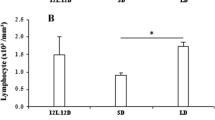Summary
Studies in Mytilus edulis have indicated that immunoregulatory activities comoparable to those in vertebrates also exist in invertebrates. Mytilus immunocytes resemble cells of the vertebrate monocyte/macrophage lineage and are activated by similar substances. We searched for differential effects of opioids on these cells in comparison with those of lipopolysaccharide (LPS), in order to determine if different subpopulations of immunoactive hemocytes are involved. We showed that Mytilus immunocytes respond to LPS in a fashion similar to that in vertebrate granulocytes by flattening, and increasing in cellular perimeter and mobility, that LPS administered in vivo results in a lowering of the number of free hemocytes that can be obtained from the animal, and that distinct immunoactive cell populations seem to exist since apparently different subsets of cells react when exposed to LPS or opioids and the opioid antagonist naloxone.
Similar content being viewed by others
References
Beck G, Habicht GS (1986) Isolation and characterization of a primitive interleukin-1-like protein from an invertebrate, Asterias forbesi. Proc Natl Acad Sci USA 83:7429–7433
Beck G, Vasta GR, Marchalonis JJ, Habicht GS (1989) Characterization of interleukin-1 activity in tunicates. Comp Biochem Physiol 92B:93–98
Blalock JE (1989) A molecular basis for bidirectional communication between the immune and neuroendocrine systems. Physiol Rev 69:1–32
Carswell EA, Old LJ, Kassell RL, Green S, Williamson B (1975) An endotoxin induced serum factor that causes necrosis of tumors. Proc Natl Acad Sci USA 72:3666–3670
Felten DL, Felten SY, Bellinger DL, Carlson SL, Ackerman KD, Madden KS, Olschowka JA, Livnat S (1987) Noradrenergic sympathetic neural interactions with the immune system: structure and function. Immunol Rev 100:225–260
Hughes TK, Smith EM, Chin R, Cadet P, Sinisterra J, Leung MK, Shipp MA, Scharrer B, Stefano GB (1990a) Interaction of immunoactive monokines (interleukin-1 and tumor necrosis factor) in the bivalve mollusc, Mytilus edulis. Proc Natl Acad Sci USA 87:4426–4429
Hughes TK, Smith EM, Barnett J, Charles R, Leung MK, Stefano GB (1990b) Endotoxin activation of Mytilus edulis immunocytes: evidence for a role of immunoreactive tumor necrosis factor and interleukin-1. Dev Comp Immunol (in press)
Leung MK, Stefano GB (1987) Comparative neurobiology of opioids in invertebrates with special attention to senescent alterations. Prog Neurobiol 28:131–159
Mizel SB (1989) The interleukins. FASEB J 3:2379–2388
Morrison DC, Rudbach JA (1981) In: Inman P, Mandy WJ (eds) Contemporary topics in molecular immunology, vol 8. Plenum, NY, pp 187–218
Pipe RK (1990) Differential binding of lectins to haemocytes of the mussel, Mytilus edulis. Cell Tissue Res 261:261–268
Renwrantz L (1990) Internal defense system of Mytilus edulis. In: Stefano GB (ed) Neurobiology of Mytilus edulis. Manchester University Press, Manchester, UK
Renwrantz L, Stahmer A (1983) Opsonizing properties of an isolated hemolymph agglutinin and demonstration of lectin-like molecules at the surface of hemocytes from Mytilus edulis. J Comp Physiol 149:535–546
Stefano GB (1989) Role of neuropeptides in immunoregulation. Prog Neurobiol 33:149–159
Stefano GB, Cadet P, Scharrer B (1989a) Stimulatory effects of opioid neuropeptides on locomotory activity and conformational changes in invertebrate and human immunocytes: evidence for a new subtype of delta receptor. Proc Natl Acad Sci USA 86:6307–6311
Stefano GB, Leung MK, Zhao X, Scharrer B (1989b) Evidence for the involvement of opioid neuropeptides in the adherence and migration of immunocompetent invertebrate hemocytes. Proc Natl Acad Sci USA 86:626–630
Stefano GB, Zhao X, Bailey D, Metlay M, Leung MK (1989c) High affinity dopamine binding to mouse thymocytes and Mytilus edulis (Bivalvia) immunocytes. J Neuroimmun 21:67–74
Author information
Authors and Affiliations
Rights and permissions
About this article
Cite this article
Hughes, T.K., Smith, E.M., Barnett, J.A. et al. Lipopolysaccharide and opioids activate distinct populations of Mytilus edulis immunocytes. Cell Tissue Res 264, 317–320 (1991). https://doi.org/10.1007/BF00313968
Accepted:
Issue Date:
DOI: https://doi.org/10.1007/BF00313968




